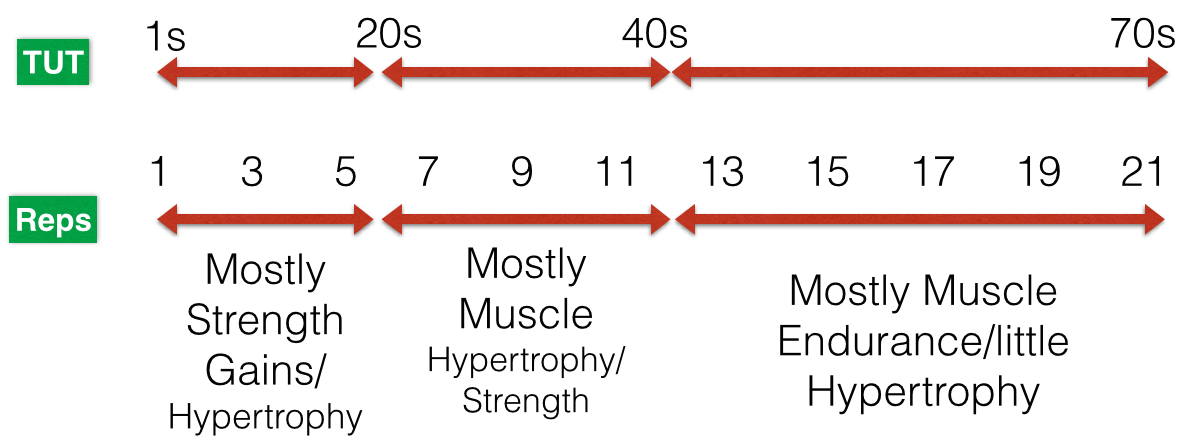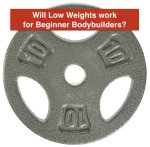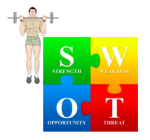How to Use the Time Under Tension technique for Muscle Growth and Hypertrophy
Quick question for you. Which works best for muscle hypertrophy?
High reps or low reps? Think. Think!
 Tension is the language of your Muscles!
Tension is the language of your Muscles!Just like any other bodybuilder I was obsessed with reps and sets. How many reps for optimal muscle gains, How many sets, etc.
Added to this was the confusion created by bodybuilders and muscle coaches. Some say low reps work best, and others say high reps! Who is right?
Actually both are right, but for different reasons. Low rep training creates myofibrillar hypertrophy and high rep training creates sarcoplasmic hypertrophy. Since you need both types of hypertrophy, you need to have a method which ensures that.
Enter Time under Tension, the latest secret coming out of muscle research and few bodybuilders' training arsenal.
Although known since couple of decades, Ben Pakulski is the best exponent of this technique. Check out his Mass intentions Program for more details.
In this article, I will show you the best TUT technique, optimal TUT and how to combine rep speed and TUT techniques for maximum muscle gains.
Inside this article
- What is Muscle tension and Time under Tension {TUT}
- What is optimal time under tension for muscle hypertrophy
- Importance of TUT for Bodybuilders
- The perfect rep speed for muscle growth
- Drawbacks of TUT Technique
- Summary, Action Steps and Recommended Programs
What is Muscle Tension and
Time Under Tension
 Your ability to generate maximum muscle tension will dictate the speed of your muscle gains.
Your ability to generate maximum muscle tension will dictate the speed of your muscle gains.Do you know the most important word in the bodybuilding dictionary?
No its not Muscle. Its Intensity. Everything comes second.
Intensity is important because it dictates Muscle Tension, and muscle tension is the primary stimulus for muscle growth. {1}
Tension is the language of muscles. Along with intensity or load, it is the most important determinant for optimal muscle workout.
All your training goals are aimed at one thing: Maximising muscle tension.
Two ways you can increase muscle tension:
You can increase muscle tension either by:
- using heavy weights or
- slowing your rep speed
Heavy weights directly creates high intramuscular tension and slow rep speed maintains that tension for longer duration.
More muscle tension means more muscle damage and hence more repair and growth. Meaning - Bigger Muscles.
Hence, more Time Under Tension or TUT = More Muscle Growth.
In this article you will find optimal training technique for maximising TUT.
What is TUT or Time Under Tension Technique
Muscle growth is not about reps, sets and rest periods only. It all boils down to how much time the muscles spent under tension.
Time under tension is training technique popularised by Canadian strength coach Charles Poliquin popularised in 2000 and later improvised by Australian Strength coach Ian King and others.
"Time under tension means the amount of time your muscles were under tension".
It is the time from the beginning of a set to the end of the set.
So if you took 25 seconds to complete a set of 8 reps, then the time under tension or TUT was 25 seconds and each rep was performed for 3 seconds approximately.
Why is TUT important for Bodybuilders
As you know that you grow muscles by two methods, each equally important for total muscular development.
1. High threshold muscle training with heavy weights to target type II fibers with maximum growth potential.
2. High metabolic stress which stimulates protein synthesis and hormone release.
Time under tension technique maximises the second factor of metabolic stress and hence stimulates muscle hypertrophy.
More TUT means:
- more shearing of the myofibrils -->
- increased satellite cell proliferation -->
- more amino acid uptake and -->
- hence more muscle stimulation for growth.
What is Optimal Time Under Tension for Muscular Hypertrophy

Time Under Tension
A. 1 to 20 seconds
B. 20 to 40 seconds
C. 40 to 70 seconds
The Training Effect
A. Mostly Strength Gains/Myofibrillar hypertrophy
B. Most Sarcoplasmic Hypertrophy
C. Mostly endurance and hypertrophy
To maximise TUT technique for muscle growth, you need to train with heavy weights for 20 to 40 seconds. Some experts say even up to 70 seconds to maximise all muscle fibers.
And Scientific research agrees with these recommendations.
In the first 10-20 seconds, you are primarily training your type IIB high threshold muscle fibers causing myofibrillar damage and hypertrophy by adding contractile proteins.
As you move between 20 to 40 seconds, you train both type IIA and type IIB fibers causing sarcoplasmic hypertrophy through satellite cell proliferation
During 40 to 70 seconds, you train type I muscle fibers mainly which are built for endurance causing addition of mitochondria and capillaries.
Increased TUT or duration of your set will work almost all the motor fibers and create immense metabolic stress. And metabolic stress is the second way muscles grow.
More metabolic stress = anabolic hormones = muscle growth
Research has proven that more muscle tension stimulates the mTOR pathway of protein synthesis which translates to more muscle repair and growth. {2}
But there is a catch. Since type IIB fibers hold maximum growth potential and you need heavy weights to train them how can you extend your sets to last 40 seconds?
You do that by the...
The Perfect Rep Speed
Solution: Controlled repetitions in 4020 rep scheme.
It means:
- 4 seconds to lower the weight {eccentric},
- 0 second pause
- 2 seconds to lift the weight and
- 0 seconds pause
By performing exercise in a controlled manner you can increase the time under tension. Using the above rep scheme you can select a weight you can do 10 reps max and ideally have a TUT of 60 seconds.
But since you will be doing in more controlled manner, you might be able to do only 6 reps, which equals 36 seconds, which is optimal for muscle growth.
Why 4020 and not 2040?
So why not slower concentric and faster eccentric?
In other words, why not faster lowering and slower lifting?
Because eccentrics or lowering or weights cause more muscle damage and is proven to result in more muscle hypertrophy.
So by using 4020 tempo, you get the best of both the worlds.
You lift heavy load, although not as heavy as lifting 1-2 reps, but still heavy enough for muscle hypertrophy
You lift faster, which is great for targeting type II muscle fibers
You lower slower, which is great for eccentric muscle hypertrophy
Additionally since you do reps in a controlled fashion, you master proper exercise technique. You will learn how to feel the muscles, activate them, intentionally.
Special tips for Hardgainers
I have found 20-40 second sets best for ectomorph hardgainers like me and my clients. Since ectomorphs have lower type II fibers, you should train them more.
Higher TUT 40 seconds and beyond build muscular endurance and should be done rarely if at all.
Drawbacks of Time under Tension Technique
1. Pain: Doing controlled reps is very uncomfortable. Pumping heavy iron for 10-20 seconds is tough, and to do it for 40 seconds can be very painful. But as they say, NO PAIN, NO GAIN.
2. Lower loads: Since you will be doing the reps little slower, you cannot do the same reps with same weight like before.
For example: Doing 8 reps using conventional method might mean, a 24 second TUT, considering a 3 second rep.
But with a more controlled tempo of 4020, doing the same might mean 6 reps only, each rep of 6 seconds each.
So obviously the reps have come down, or if reps are to be kept constant, the load has to come down. and lower loads mean less stimulation of fast twitch type II muscle fibers.
The Sweet Spot
5 to 8 reps done in a controlled 4020 tempo totalling 30 to 48 seconds is the perfect sweet spot for muscle hypertrophy.
It is perfect for stimulation of all the muscle fibers, especially type IIA and type IIB fibers.
Since you will be doing lower reps than usual bodybuilding zone of 5-12, you can add more sets.
Remember workout volume = sets X reps.
So if reps fall, increase sets to makeup the training volume.
How to Progress with Time Under Tension Principle
I have found a great way to progress with TUT. I use it once every few months.
Heres is how it goes.
Lets say your 10 RM, or a weight with which you can do maximum 10 reps is 100 pounds.
Perform the 10 reps with 4020 tempo noting time taken to complete the set.
Write down the time taken. Lets say it is 25 seconds.
For next 4 weeks, keep the load constant but progress on TUT
- Week 1: 25s
- Week 2: 30s
- Week 3: 35s and
- Week 4: 40s
If you do nothing but increase time under tension you will have added pounds to your body. Try this technique for 4 weeks, eat like a horse and sleep like a log. You can send me thank you email later.
Low rep training for bodybuilders?
You are looking for total muscular development and you achieve that by targeting all muscle fiber types, not just type IIB.
Include a variety of reps in your workouts. {3}
You should be doing:
- low rep training 5x5 type for muscle strength {3-4 weeks in a 12-16 week cycle}
- Moderate rep training 5 to 9 for muscular hypertrophy {8-10 weeks in a 12-16 week cycle}
- High rep training 10-30 for muscular endurance {1-2 weeks in a 12-16 week cycle}.
Summary and Action Steps
- Load and tension are the two critical determinants of muscle hypertrophy workout
- Time under tension is an excellent alternative to counting reps alone
- The optimal time under tension for muscle growth and hypertrophy is 20-40 seconds, and 40-70 seconds for muscular endurance
- Using a 4020 tempo for reps is the perfect solution to train heavy yet get higher time under tension
- You can add more sets in case of low rep training and increase total time under tension
- Perform variety of rep ranges to get total muscular development.
Referances:
1. Fry, AC. The role of resistance exercise intensity on muscle fibre adaptations. Sport Med 34: 663–679, 2004.
2. Hamilton D.L., A. Philp, M.G. MacKenzie, A. Patton, M.C. Towler, I.J. Gallagher, S.C. Bodine, and K. Baar. Molecular brakes regulating mTORC1 activation in skeletal muscle following synergist ablation. Am J Physiol Endocrinol Metab. 2014 Aug 15;307(4):E365-73.
3. McDonagh, MJN and Davies, CTM. Adaptive response of mammalian skeletal muscle to exercise with high loads. Eur J Appl Physiol 52: 139–155, 1984.
Recent Articles
-
Bodybuilding Workouts & Muscle Building Workout Routines that Build Muscle
Jul 01, 17 09:52 AM
Discover effective bodybuilding workouts and muscle building routines with strategies to make every workout a killer one. Download free 3-day, 4-day or 5-day workout routines. -
Why Beginner Bodybuilders must use Light Weights for Muscle Gain
Jul 01, 17 09:44 AM
Discover the science why beginner bodybuilders must use light to moderate weights to gain maximum muscle mass in the first 2-3 months of training to gain muscle, prevent injuries and grow bigger. -
How to do a S.W.O.T Analysis of Your Bodybuilding Workout
Oct 26, 16 01:41 AM
Looking to take your bodybuilding workout to the next level? Then do a SWOT analysis of your muscle building workout to increase your lifts every workout.




